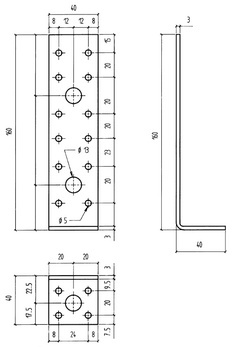Angle bracket type B1 For timber structures, solid 3 mm design
Angle connector B1
ANGL-WOCON-B1-40X40X160X3,0

Register and access more than 75 000 products
- Low offset between the wooden construction and concrete anchoring
- Slim construction for low application
- Plates hot-dip galvanised on both sides (DX51D + Z275 (approx. 20 µm)) of thickness 3.0 in accordance with EN 10327:2004
- Application in use class 1 and 2 according to EN 1995:2013
- For higher requirements, the use of reinforced angle connectors or tension anchors is recommended
European technical approval ETA-09/216
The diameter of bolts/screws/anchors may only be max. 2 mm smaller than the diameter of the hole.
The respective basic conditions of the applicable anchor approval must be observed.
European technical approval ETA-09/216
Datasheets(X)
Load-bearing connections of timber joists to wood or concrete such as joist to joist, purlin to joist or post on concrete substrates.
Suitable fasteners:
- Comb/ribbed nail in line with EN 14592: 4.0 x 40 mm
- ASSY 3.0 combination screw in line with ETA 11/0190: d = 12 mm
- Bolts according to manufacturer specification: M12
- Recommended dowels for anchoring in concrete: W-BS; W-FAZ; W-VIZ; WIT-VM 250; WIT-UH 300
 | |
Type | B1 |
Width x height x depth | 40 x 160 x 40 mm |
Thickness | 3 mm |
Design | Without bar |
Number of D 13 mm holes in subcarrier nJ/main carrier nH | 2 + 1 PCS |
Number of D 5 mm holes in subcarrier nJ + main carrier nH | 12 + 4 PCS |
Approval | ETA-09/0216 |
Product weight (per item) | 164.698 g |
Material | Steel |
Surface | Hot dip galvanized |
Weight | 162 g |
Material designation | DX51D |
Material standard | DIN EN 10327:2004 |
Number of D 5 mm holes | 16 PCS |
Number of D 13 mm holes | 3 PCS |
| Characteristic load capacity in kN of type B1/B2 angle bracket according to ETA-09/0216 with ring-shank nail - purlin/post | |||||||||||
| Angle bracket B1/B2 | Article number | ETA | Ring-shank nail in | Angle bracket B1/B2 for each connection | |||||||
| F1,Rk | F2/3,Rk | F4,Rk | F5,Rk | ||||||||
| Width x length x depth x thickness in mm | Steel | Wood | Wood | Steel | Wood | Steel | |||||
| mm | kN | kN | kN | kN | kN | kN | kN | ||||
| 1 angle B | 40x90x42x3 mm | 0681 035 90 | 09/0216 | 4x40 | 0,92 | 1,37 | 2,56 | - | - | - | - |
| 40x160x42x3 mm | 0681 050 160 | 09/0216 | 4x40 | 0,92 | 1,37 | 2,73 | - | - | - | - | |
| 2 angle B | 40x90x42x3 mm | 0681 035 90 | 09/0216 | 4x40 | 1,85 | 2,75 | 5,12 | 5,13 | 4,28 | 5,13 | 4,28 |
| 40x160x42x3 mm | 0681 050 160 | 09/0216 | 4x40 | 1,85 | 2,75 | 5,46 | 6,48 | 4,79 | 6,48 | 4,79 | |
| 3) If one angle bracket is used for each connection, the connected component must be secured against twisting. 4) The loads F4 and F5 act on the top edge of the connected component. Securing against twisting is not required. The specified load-bearing capacities apply to coniferous wood at 350 kg/m³ ≤ rk ≤ 420 kg/m³. For wood at 290 kg/m³ ≤rk≤ 350 kg/m³, the specified load-bearing capacities for wood must be multiplied by the factor kdens: tSteel ≥ 2.5 mm: kdens = (pk/350)^2 tSteel = 1.5 mm: kdens = (pk/350)^0.8 Rated values of the load-bearing capacities: Fi,Rd = min {Fi,wood,Rd; Fi,steel,Rd} failure of the fastener in the wood: Fi,Wood,Rd = kmod / ƳM,Wood × Fi,Wood,Rk with ƳM,Wood = 1.3 Steel failure of the connector: Fi,Steel,Rd = Fi,Steel,Rk / ƳM,Steel with ƳM,Steel = 1.25 For several simultaneous loads, the following condition must be met: The specified nailing patterns must be observed in accordance with the relevant ETA. | |||||||||||
| NOTE: These are guides for planning purposes. The values must be calculated for each project by authorised persons. | |||||||||||
| Characteristic load capacity in kN of type B1/B2 angle bracket according to ETA-09/0216 with ring-shank nail - purlin/post | |||
| Steel or reinforced concrete connection with a stud/stud anchor | |||
| Angle bracket B1/B2 | eB | z | (1+eB/z) |
| 40x90x42x3 mm | 24,5 | 17,5 | 2,4 |
| 40x160x42x3 mm | 24,5 | 17,5 | 2,4 |
| FB,Ed = F1,d x (1+ eB/z) If the load F4 or F5 acts with a higher eccentricity "e" than the top edge of the angle, an additional ΔF1 load must be applied to both angles. This is applied at the angles by an additional momentum and a pair of forces. B is the distance between the angles (width of the component to be connected). ΔF1,d = F4,d / F5,d x e/B | |||
Select RAL-colour code
!! NOTE: On-screen visualisation of the colour differs from real colour shade!!







